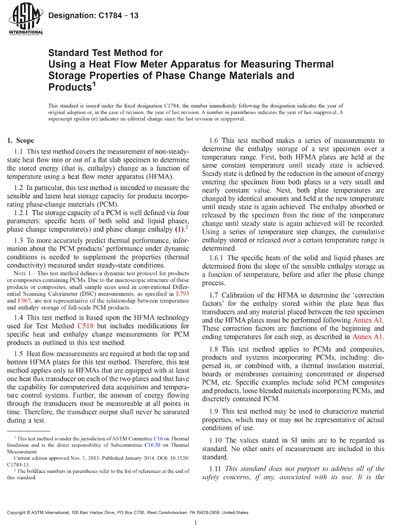Historical
ASTM C1784-13
Standard Test Method for Using a Heat Flow Meter Apparatus for Measuring Thermal Storage Properties of Phase Change Materials and Products
1.1 This test method covers the measurement of non-steady-state heat flow into or out of a flat slab specimen to determine the stored energy (that is, enthalpy) change as a function of temperature using a heat flow meter apparatus (HFMA).
1.2 In particular, this test method is intended to measure the sensible and latent heat storage capacity for products incorporating phase-change materials (PCM).
1.2.1 The storage capacity of a PCM is well defined via four parameters: specific heats of both solid and liquid phases, phase change temperature(s) and phase change enthalpy (1).2
1.3 To more accurately predict thermal performance, information about the PCM products’ performance under dynamic conditions is needed to supplement the properties (thermal conductivity) measured under steady-state conditions.
1.4 This test method is based upon the HFMA technology used for Test Method C518 but includes modifications for specific heat and enthalpy change measurements for PCM products as outlined in this test method.
1.5 Heat flow measurements are required at both the top and bottom HFMA plates for this test method. Therefore, this test method applies only to HFMAs that are equipped with at least one heat flux transducer on each of the two plates and that have the capability for computerized data acquisition and temperature control systems. Further, the amount of energy flowing through the transducers must be measureable at all points in time. Therefore, the transducer output shall never be saturated during a test.
1.6 This test method makes a series of measurements to determine the enthalpy storage of a test specimen over a temperature range. First, both HFMA plates are held at the same constant temperature until steady state is achieved. Steady state is defined by the reduction in the amount of energy entering the specimen from both plates to a very small and nearly constant value. Next, both plate temperatures are changed by identical amounts and held at the new temperature until steady state is again achieved. The enthalpy absorbed or released by the specimen from the time of the temperature change until steady state is again achieved will be recorded. Using a series of temperature step changes, the cumulative enthalpy stored or released over a certain temperature range is determined.
Content Provider
ASTM International [astm]






